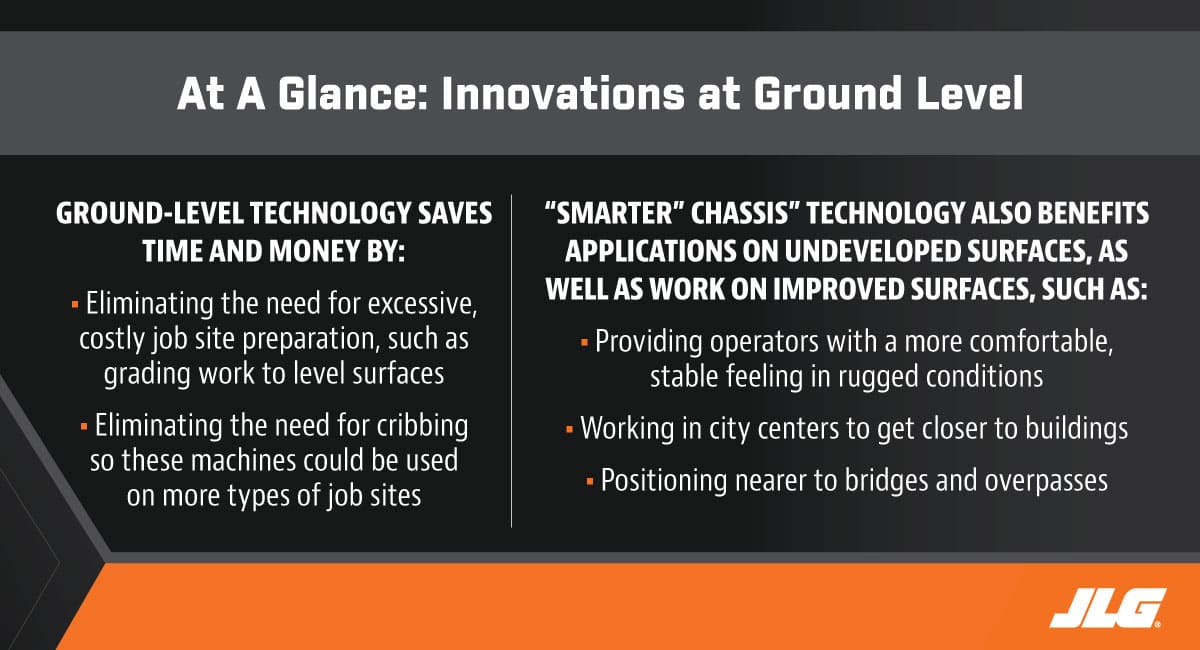 Rachel Lawler
Rachel Lawler
Engineering Communications Specialist
____
JLG Industries
The access industry contains many scissor lifts from a wide variety of manufacturers, and at first glance, they may seem interchangeable. However, more discerning buyers focus on equipment models offering features that will make their teams more productive in the field.
There are many technologies available that deliver intuitive operation and enhance performance while lowering operating costs, but one new technology available on scissor lifts also simplifies operation and boosts productivity. This advanced feature — variable tilt technology — enables operators to reach more, even when operating on slopes.

What is variable tilt?
Most slab scissor lifts cannot elevate when working on a side slope greater than 1.5 degrees. Variable tilt technology is designed to maximize a scissors lift’s height based on the slope on which the machine is positioned. Scissor lifts equipped with variable tilt technology provide a larger working envelope by allowing the machine to lift on side slopes greater than 1.5 degrees while limiting the maximum platform height automatically.
On typical scissor lifts, if the machine is working at greater than 1.50 degrees of slope, the lift would not be able to elevate and reach the heights needed to efficiently complete a job. Variable tilt technology allows scissor lifts to elevate on slide slopes as great as 3.00 degrees, giving the operator a greater degree of flexibility on the jobsite.
For example, the JLG® R1932 scissor lift, provides a large work envelope by allowing the machine to operate on slopes as high as 3.00-degrees. While an increase of only a couple of degrees may seem like a minor improvement, operators of this machine get an increase of operating area up to 75% on sloped surfaces.
An explanation of how variable tilt technology works
Variable tilt technology utilizes a sensor suite that measures the slope of the machine, the load in the platform and the current height of the platform. When the machine is in operation, the system compares the slope of the machine to a predefined table indicating the maximum height that the machine can be safely used by the operator. The limits of the machine are continuously communicated to the operator through a series of lights indicating the zones in which the machine can operate. The calculations and controls happen in the background, providing the operator the information they need in the platform so that they can complete their task quickly and efficiently.
Variable tilt technology varies from model to model as well as when working indoors versus outdoors. Looking at the JLG R1932 scissor lift as an example, the top light of the variable tilt display is lit only when the machine is capable of lifting to a full height of 19 ft (5.79 m). When the middle light on the display is lit the machine can elevate up to 17 ft (5.18 m). And finally, when only the bottom light is lit, the machine can elevate up to 15 ft (4.57 m). This system provides operators with an easy-to-understand guide to height restrictions, while taking into account the grade on which the machine is operating.
Challenges and benefits of variable tilt technology
Developing the functionality of variable tilt technology does come with some challenges. The system software must consider a large combination of machine slopes, platform heights and loads. The system must also consider whether the operator is currently lifting or driving the machine. All of these variables must be derived and tested to ensure the stability of the machine and compliance with the associated regulatory standards.
The in-depth development of this system, though, provide for an uncomplicated end-user experience. You may think that more controls and more limits would mean more machine issues, such as lift restrictions; however, the opposite is true. Productivity can greatly increase with the gain of a larger working envelope with fewer machine restrictions. For example, by increasing the work envelope on JLG scissor lifts, there are decreasing machine alarms, which means better machine utilization time — and getting the job done faster.
Scissor lift manufacturers like JLG continue to focus on the areas of operator productivity, safety and cost of ownership, offering a broad range of models that cater to the specific needs of its customers through innovative solutions. Variable tilt technology is just one example of innovation that enhances productivity in the real world by allowing users to expand their work envelope.
Do you want to stay up to date with industry news and issues similar to this? Make sure you subscribe below to receive monthly updates from Direct Access with newly posted content so you never miss important information.